Exercise - Provision Azure resources
In this exercise, you'll configure an automation workflow to provision your Terraform resources.
Access the sample application
In this exercise, you'll create a GitHub repository from a template that contains all the code for Terraform provisioning.
On GitHub, go to the main page of the repository:
https://github.com/MicrosoftDocs/mslearn-java-petclinic-simplifiedAbove the file list, select Use this template, then select Create a new repository.

In the Repository name box, enter a unique name for your repository. Be sure to follow the naming convention for GitHub repositories.
Ensure that the Private option is selected, and then select Create repository.
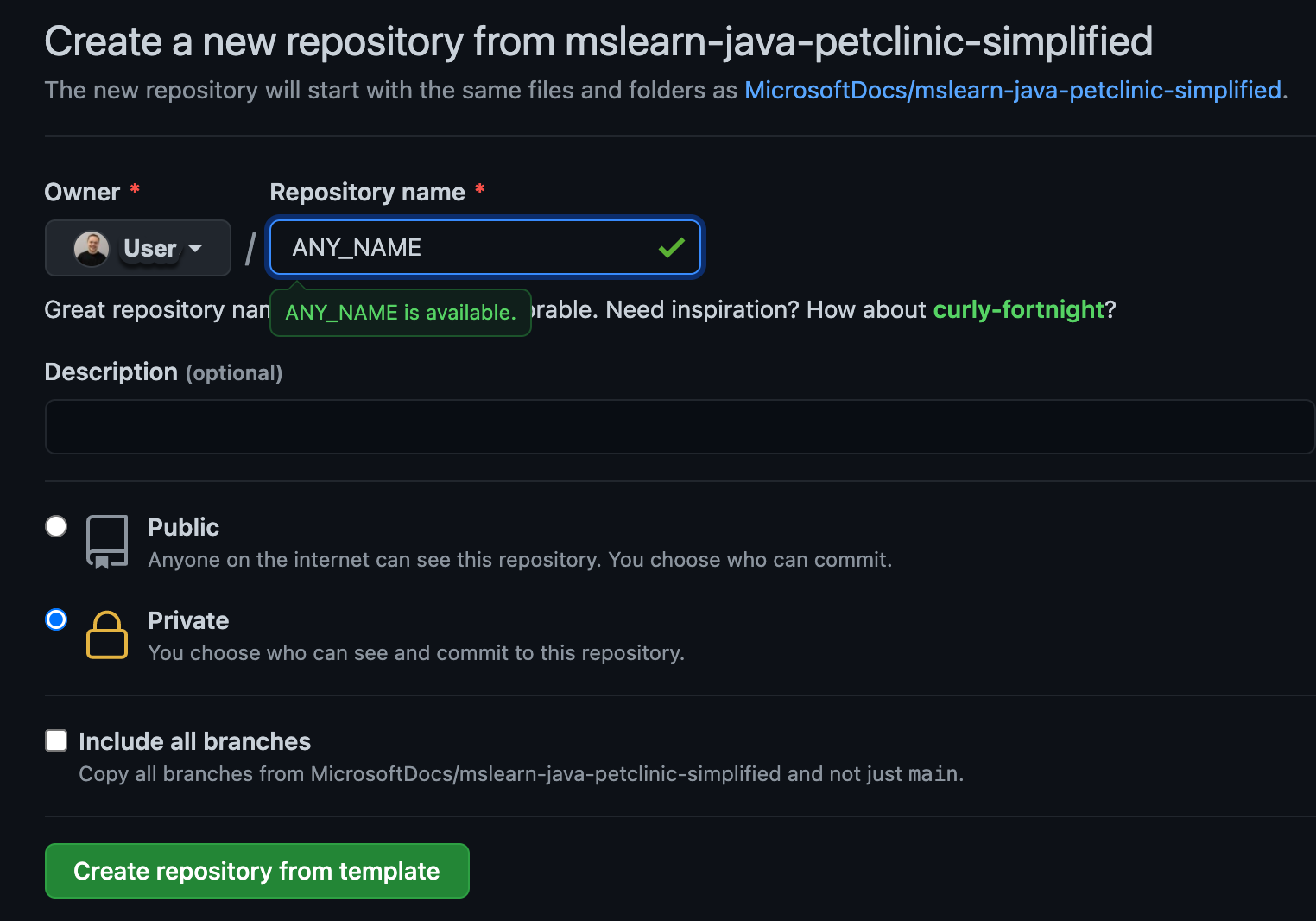
Workflow
Inside the project directory for the repository you've created, you'll see a directory called terraform and, within it, a file called main.tf.
Let's look at a few sections that you might use to define your module's configuration:
- Provider: A Terraform configuration file starts with the specification of the provider. When you use Azure, you specify the Azure provider (
azurerm) in the provider block. - Terraform: The Terraform version with which you're working.
- Data: Gets data from existing services.
- Locals: Generates new variables by using functions and expressions.
- Resource: Describes resources and dependencies.
- Module: Reusability and complexity abstraction.
To provision our application and database, we'll only need to include the Provider and Resource sections.
Next, open the main.tf file and review the outline and comments:
provider "azurerm" {
version = "=2.20.0"
features {}
}
# Creates a resource group
resource "azurerm_resource_group" "main" {
name = var.resource_group
location = var.location
tags = {
"Terraform" = "true"
}
}
resource "random_password" "password" {
length = 32
special = true
override_special = "_%@"
}
# Creates a MySQL server
resource "azurerm_mysql_server" "main" {
name = "${azurerm_resource_group.main.name}-mysql-server"
location = azurerm_resource_group.main.location
resource_group_name = azurerm_resource_group.main.name
administrator_login = "petclinic"
administrator_login_password = random_password.password.result
sku_name = "B_Gen5_1"
storage_mb = 5120
version = "5.7"
auto_grow_enabled = true
backup_retention_days = 7
geo_redundant_backup_enabled = false
infrastructure_encryption_enabled = false
public_network_access_enabled = true
ssl_enforcement_enabled = true
ssl_minimal_tls_version_enforced = "TLS1_2"
}
# The database that your application will use
resource "azurerm_mysql_database" "main" {
name = "${azurerm_resource_group.main.name}_mysql_db"
resource_group_name = azurerm_resource_group.main.name
server_name = azurerm_mysql_server.main.name
charset = "utf8"
collation = "utf8_unicode_ci"
}
# Enables the 'Allow access to Azure services' check box
resource "azurerm_mysql_firewall_rule" "main" {
name = "${azurerm_resource_group.main.name}-mysql-firewall"
resource_group_name = azurerm_resource_group.main.name
server_name = azurerm_mysql_server.main.name
start_ip_address = "0.0.0.0"
end_ip_address = "0.0.0.0"
}
# Creates the plan that the service uses
resource "azurerm_app_service_plan" "main" {
name = "${var.application_name}-plan"
location = azurerm_resource_group.main.location
resource_group_name = azurerm_resource_group.main.name
kind = "Linux"
reserved = true
sku {
tier = "PremiumV2"
size = "P1v2"
}
}
# Creates the service definition
resource "azurerm_app_service" "main" {
name = var.application_name
location = azurerm_resource_group.main.location
resource_group_name = azurerm_resource_group.main.name
app_service_plan_id = azurerm_app_service_plan.main.id
https_only = true
site_config {
always_on = true
linux_fx_version = "JAVA|8-jre8"
}
# Contains application-specific environment variables
app_settings = {
"WEBSITES_ENABLE_APP_SERVICE_STORAGE" = "false"
"SPRING_PROFILES_ACTIVE" = "mysql"
"SPRING_DATASOURCE_URL" = "jdbc:mysql://${azurerm_mysql_server.main.fqdn}:3306/${azurerm_mysql_database.main.name}?useUnicode=true&characterEncoding=utf8&useSSL=true&useLegacyDatetimeCode=false&serverTimezone=UTC"
"SPRING_DATASOURCE_USERNAME" = "${azurerm_mysql_server.main.administrator_login}@${azurerm_mysql_server.main.name}"
"SPRING_DATASOURCE_PASSWORD" = azurerm_mysql_server.main.administrator_login_password
}
}
Set up your GitHub Actions workflow with Terraform
Let's provide your GitHub workflow access to your Azure account.
In the Azure CLI, create a service principal by running the following command:
Important
Replace <yourServicePrincipalName> with the service principal name you want to use.
az ad sp create-for-rbac --name "<yourServicePrincipalName>" --role contributor --scopes /subscriptions/<subscriptionId> --sdk-auth
The preceding command returns the following JSON. Copy it for use in the next step:
{
"clientId": "XXXXXXX-XXXX-XXXX-XXXX-XXXXXXXXXXXXX",
"clientSecret": "XXXXXXXXXXXXXXXXXXXXXXXXXXXXX",
"subscriptionId": "XXXXXXXXX-XXXXX-XXXX-XXXX-XXXXXXXXXXXXX",
"tenantId": "XXXXXXXX-XXXXX-XXXX-XXXX-XXXXXXXXXXX",
...
}
GitHub secrets
Your GitHub repository has a feature called Secrets, where you can store sensitive information that's used by Terraform to authenticate to Azure.
After you've created the required IDs and the secret in the preceding step, the next step in this unit is to add them to the Secrets store in your GitHub project.
For this exercise, you need to store the following secrets:
AZURE_CLIENT_IDAZURE_CLIENT_SECRETAZURE_SUBSCRIPTION_IDAZURE_TENANT_ID
To store the secrets, go to your forked GitHub repository, select Settings, and then select Secrets and variables, then select Actions on the left pane.
Create four secrets using the values returned from the creation of the Service Principal.
Be sure to store the secrets without the quotation marks (" "), as shown in the following screenshot:
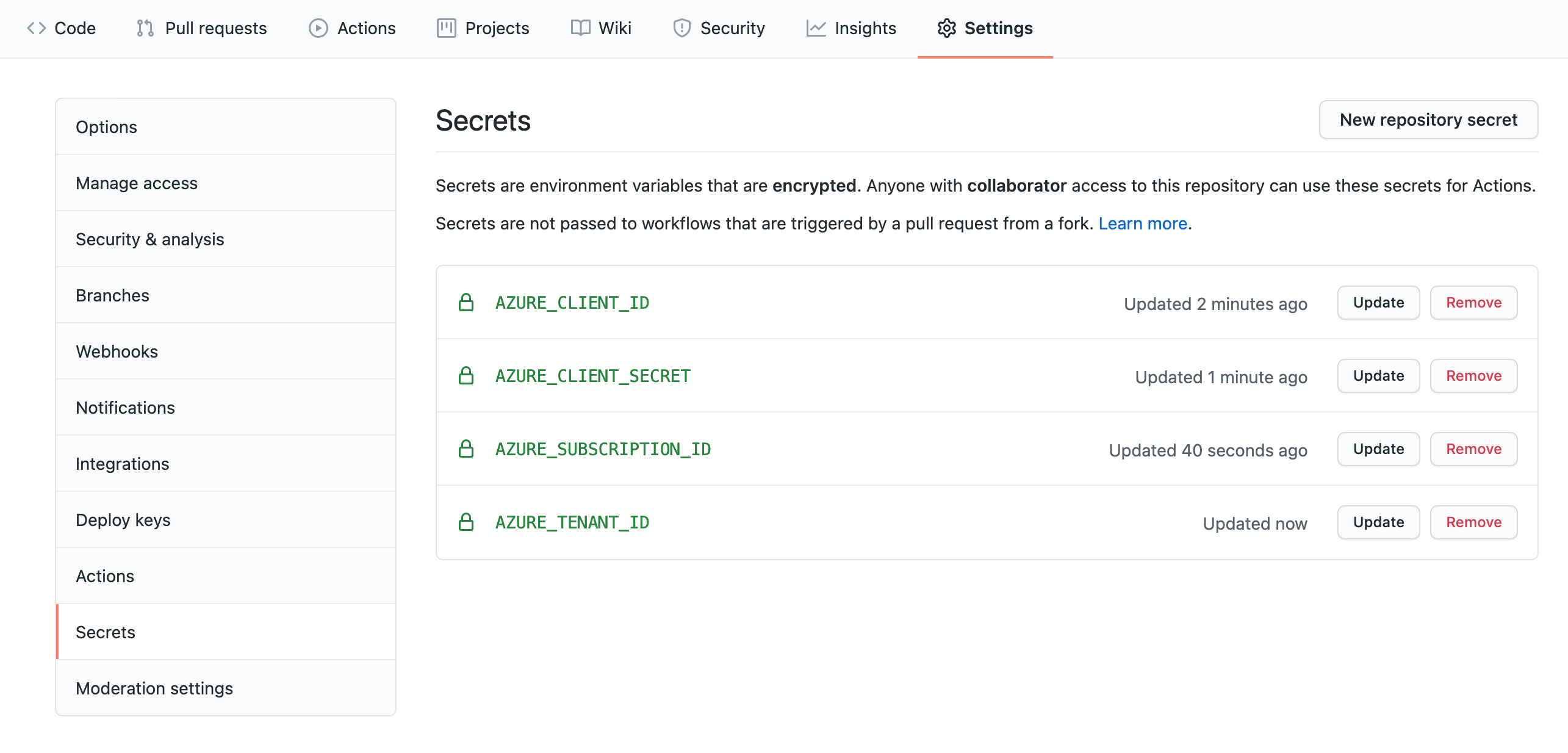
Workflow file
Inside your project directory is a directory called .github/workflows and, within it, a file called main.yml.
The main.yml file is a GitHub workflow. It uses the secret you've configured to deploy your application to your Azure subscription.
In the main.yml workflow file, you'll find the following content:
name: TERRAFORM
on:
push:
branches: [ main ]
paths:
- 'terraform/**'
pull_request:
branches: [ main ]
paths:
- 'terraform/**'
workflow_dispatch:
jobs:
terraform:
runs-on: ubuntu-latest
env:
ARM_CLIENT_ID: ${{ secrets.AZURE_CLIENT_ID }}
ARM_CLIENT_SECRET: ${{secrets.AZURE_CLIENT_SECRET}}
ARM_SUBSCRIPTION_ID: ${{ secrets.AZURE_SUBSCRIPTION_ID }}
ARM_TENANT_ID: ${{ secrets.AZURE_TENANT_ID }}
defaults:
run:
working-directory: ./terraform
steps:
- uses: actions/checkout@v2
- name: Setup Terraform
uses: hashicorp/setup-terraform@v1
- name: Terraform Init
run: terraform init
- name: Terraform Plan
run: terraform plan
- name: Terraform Apply
run: terraform apply -auto-approve
This workflow does the following actions:
- It checks whether the configuration is formatted properly.
- It generates a plan for every pull request.
- It triggers the configuration when you update files in the terraform directory.
Note
You can also trigger the GitHub Actions workflow by going to Actions, selecting the Terraform workflow, and selecting Re-run existing Jobs.
Trigger the workflow
Next, in your repository, trigger your GitHub action by:
In the built-in GitHub text editor, or in an editor of your choice, edit terraform/variables.tf as follows:
a. Change
"CHANGE_ME_RESOURCE_GROUP"to your intended resource group name.
b. Change"CHANGE_ME_APP_NAME"to your intended application name. Make sure that your application name is unique.variable "resource_group" { description = "The resource group" default = "CHANGE_ME_RESOURCE_GROUP" } variable "application_name" { description = "The Spring Boot application name" default = "CHANGE_ME_APP_NAME" } variable "location" { description = "The Azure location where all resources in this example should be created" default = "westeurope" }Commit your changes.
Verify the GitHub Actions build
In your repository, select Actions, and then select the TERRAFORM workflow on the left pane.
In the list of steps, verify that Terraform Init, Terraform Plan, and Terraform Validate have been triggered.
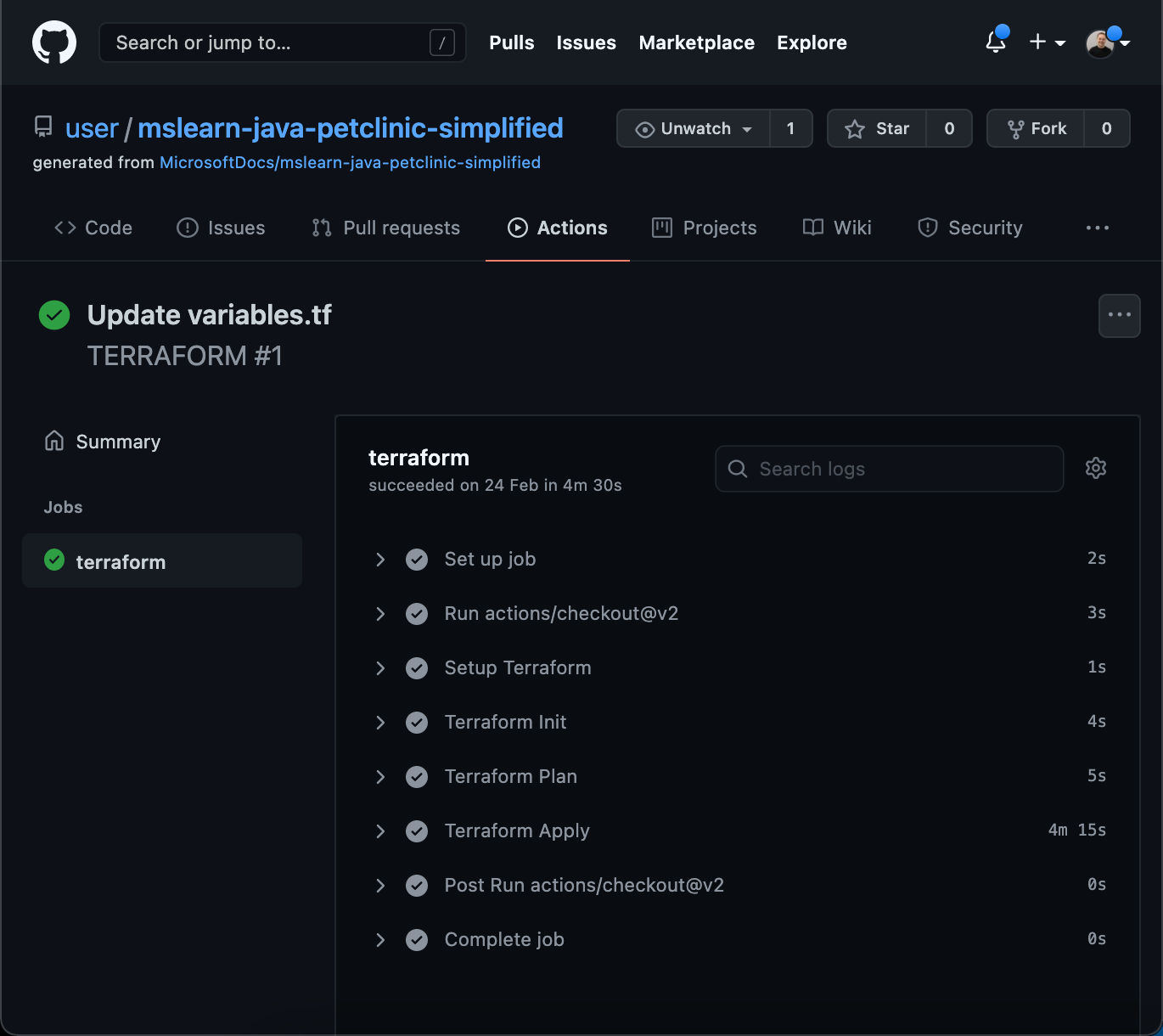
In the list of steps, expand Terraform Apply, and verify that:
Terraform has created the resources and displays the Azure instance URL.
Your Azure app instance is publicly available.
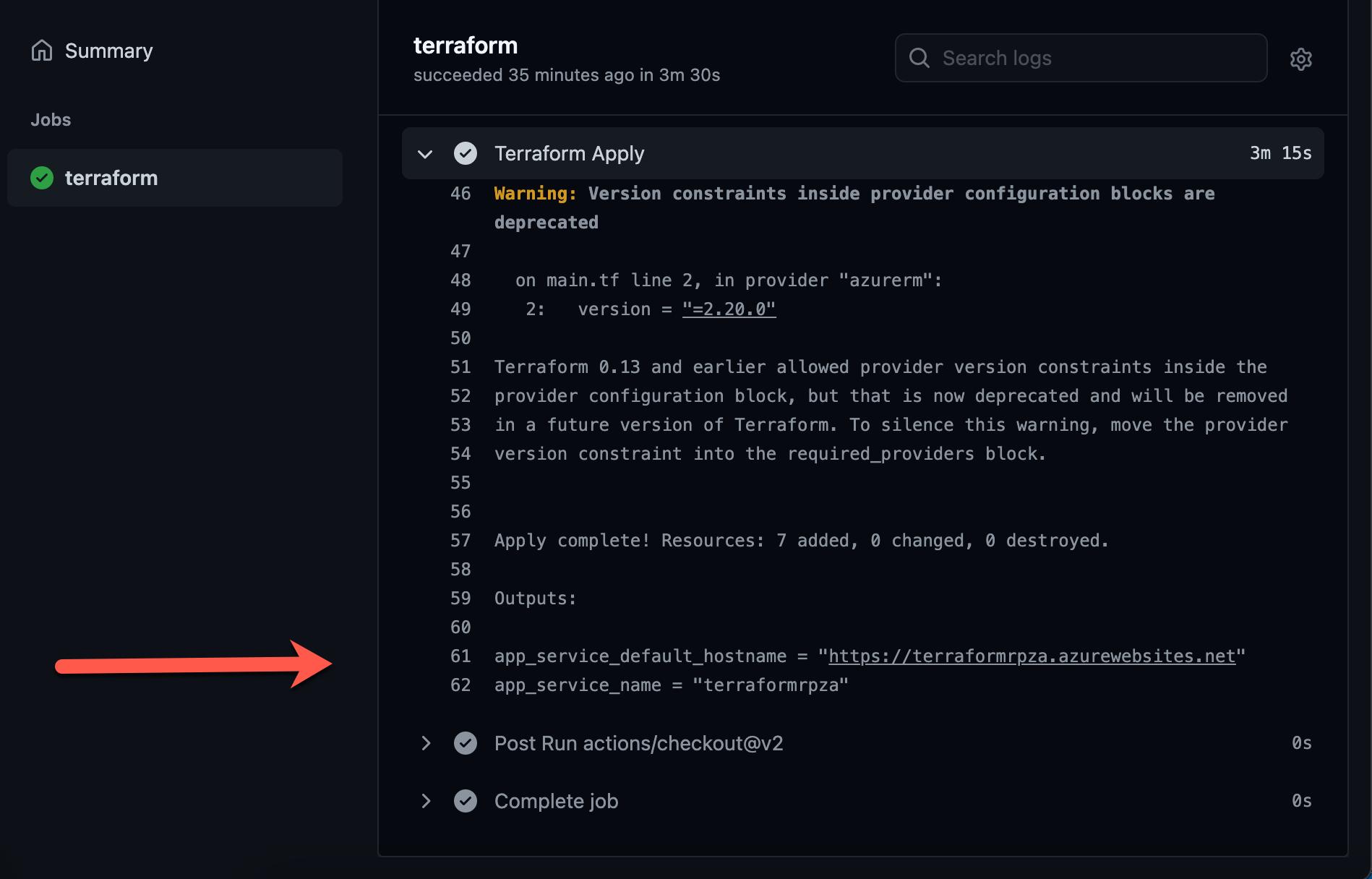
Next steps
In the next exercise, you'll use GitHub Actions to deploy a sample Spring Boot application.
Set up your application name and Azure resource group
In your GitHub repository, edit your Azure resource names by doing the following action:
In the built-in GitHub text editor, or in an editor of your choice, edit terraform/variables.tf as follows:
a. Change
"<CHANGE_ME_RESOURCE_GROUP>"to your intended resource group name.
b. Change"<CHANGE_ME_APP_NAME>"to your intended application name. Make sure that your application name is unique.variable "resource_group" { description = "The resource group" default = "<CHANGE_ME_RESOURCE_GROUP>" } variable "application_name" { description = "The Spring Boot application name" default = "CHANGE_ME_APP_NAME" } variable "location" { description = "The Azure location where all resources in this example should be created" default = "westeurope" }Commit your changes
Create an Azure Pipeline to provision your Terraform resources
In our Azure DevOps project, we'll create two separate pipelines for provisioning and build-and-deploy. The provisioning pipeline creates the Azure resources that will be released via the build-and-deploy pipeline at a later point.
Let's create the first provisioning Pipeline:
Choose your organization, and then select New project.
Specify the following parameters.
Parameter Description Project Name Required Description Optional Visibility Choose Private Advanced Version control Choose GIT Work Item Process Choose Basic Select Create project to create the project and open a welcome page.
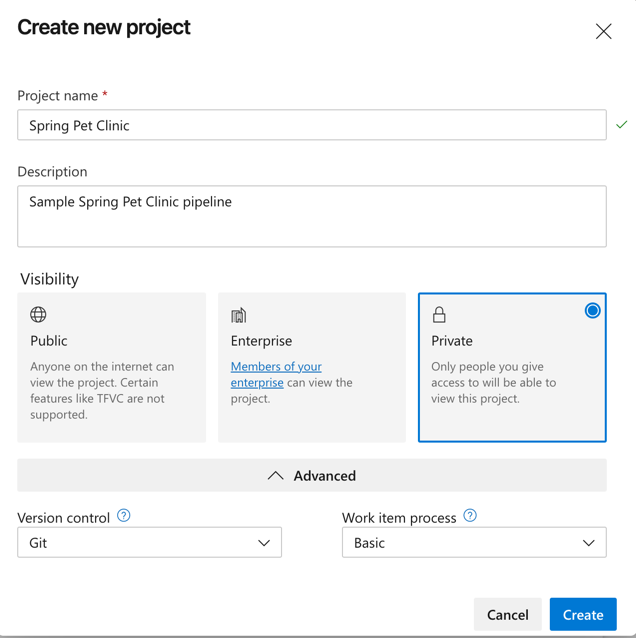
Set up your Azure Pipeline Service Connection
Let's give your Azure Pipeline access to your Azure account.
In Azure DevOps, open the Service connections page from the project settings page
Choose Create service connection and select Azure Resource Manager, then select Next.
Select Service principal (automatic), then select Next.
Specify the following parameters.
Parameter Description Scope level Select Azure Subscription Subscription Select your existing Azure subscription Resource Group Leave empty to allow users to access all resources defined within the subscription Connection Name Required. The name you'll use to refer to this service connection in task properties. This name isn't the name of your Azure subscription. Select Save to create the connection.
Create the Provision Pipeline
Important
This module's prerequisites required you to install the Terraform Azure Pipelines extension. If you haven't installed it, your pipeline won't run.
After setting up your project and connection to Azure, you'll need to create an Azure Pipeline to provision your terraform resources.
In Azure DevOps, go to your Project, select Pipelines in the left-hand menu, then select Create Pipeline.
- On the "Connect" tab, select "GitHub" (YAML file).
- If prompted to authorize GitHub access, enter your GitHub Credentials and approve the access for Azure Pipelines with the requested privileges.
- On the "Select" tab, select the GitHub Repository containing your Template.
- Select Configure pipeline on the Inventory tab.
- On the "Configure" tab, select to use an "Existing Azure Pipelines YAML file".
- In the path, select "/azuredevops/provision.yml"
- Select Continue to go the Review tab and review your pipeline.
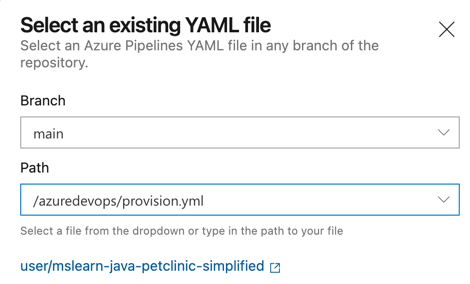
On the "Review your pipeline YAML" screen, let's inspect the Yaml file we'll use to create our Pipeline.
name: Provision Resources
trigger: none
pool:
vmImage: 'ubuntu-latest'
steps:
# Initialize the Terraform environment and bind to your Service Connection
- task: TerraformTaskV1@0
inputs:
provider: 'azurerm'
command: 'init'
workingDirectory: $(Build.Repository.LocalPath)/terraform
backendServiceArm: $(serviceConnection)
backendAzureRmResourceGroupName: $(serviceConnection)
backendAzureRmStorageAccountName: $(serviceConnection)
backendAzureRmContainerName: 'tfstate'
backendAzureRmKey: 'tf/terraform.tfstate'
# Apply the Terraform config and deploy to Azure
- task: TerraformTaskV1@0
inputs:
provider: 'azurerm'
command: 'apply'
workingDirectory: $(Build.Repository.LocalPath)/terraform
backendAzureRmContainerName: 'tfstate'
backendAzureRmKey: 'tf/terraform.tfstate'
environmentServiceNameAzureRM: $(serviceConnection)
Let's look at some of the fields we use in the config:
- serviceConnection: Your Azure PipeLine Service Connection your setup previously
- command: Your Terraform workflow command: init or apply
- backendAzure: Required fields that are needed in a team environment to store shared state.\
Before you save and run the pipeline, we need to add the variable that will bind to your service connection:
- Select Variables (Top right) and add a variable named "serviceConnection" with the value as the name of your Service Connection.
- Select OK (bottom-right corner) to save the variable.
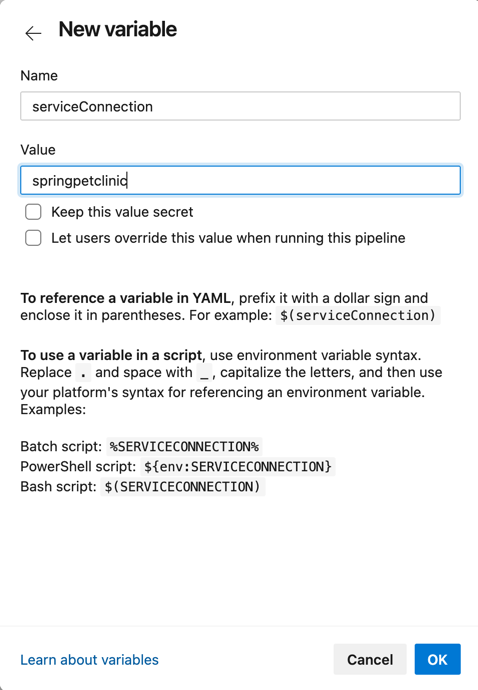
Finally, select "run" (top-right corner) to save and run the pipeline
Watch the pipeline run
Under Jobs, trace the build process through each of the steps.
As your pipeline runs, watch as your first Terraform init stage, and then your second apply stage, go from blue (running) to green (completed). You can select the stages to watch your pipeline in action.
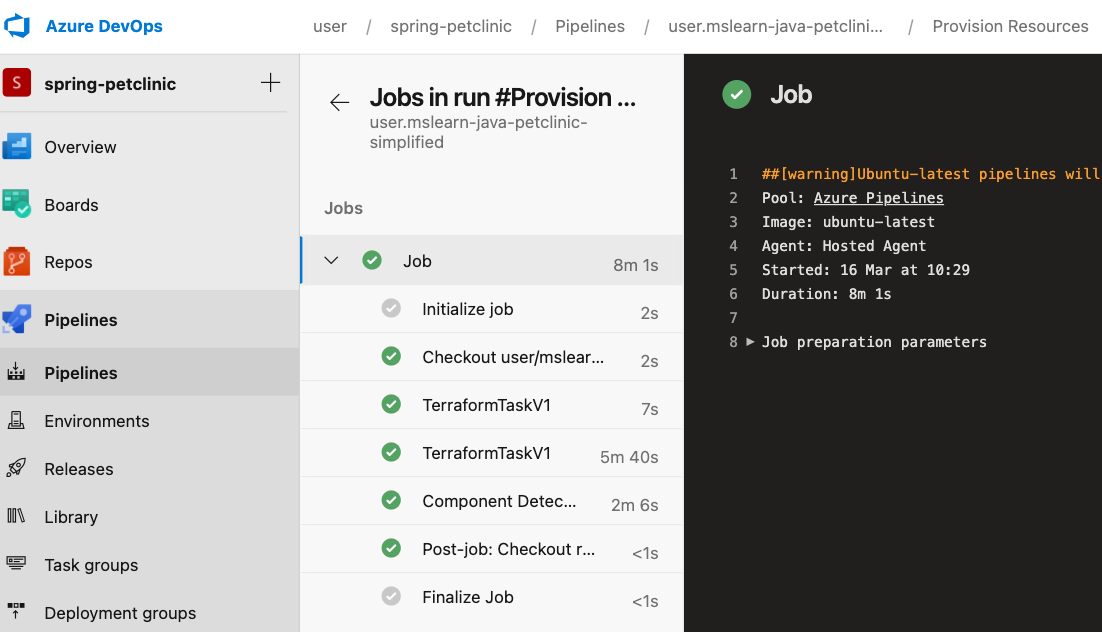
Tip
Check your email. You might have already received a build notification with the results of your run. You can use these notifications to know whether each build passes or fails.
Next steps
In the next exercise, you'll use Azure Pipelines to build and deploy your sample Spring Boot application.